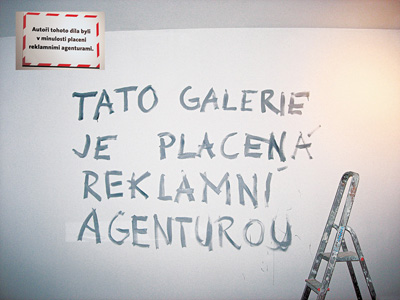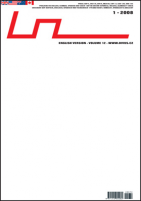| Umělec 2008/1 >> Artistic institutions begging for a facelift | Просмотр всех номеров | ||||||||||||
|
|||||||||||||
Artistic institutions begging for a faceliftUmělec 2008/101.01.2008 Edith Jeřábková | closer look | en cs de es |
|||||||||||||
|
I’ve always been used to approaching art galleries in the same way as exhibit halls in museums; as spaces designated for art. But recently galleries have been turning into living beings that have their own characters, negotiations and habits. They’ve always had them, but now it’s even more obvious. Now, galleries also speak. For example, the gallery at the Old Town Hall is holding a Mark Ther exhibit, saying that, yes, its displaying his videos, but otherwise it wants nothing to do with them. I always thought that the curator and the institution want to say something to the world with an exhibit. Yet the City Gallery of Prague seems to be making it clear to modern art that it should be happy it’s being exhibited at all. The audience ends up being like fast-food tourists – here you have it, now go eat it somewhere else, just in case you get sick from it.
The recently re-opened Špálovka (Gallery of Václav Špála) is speaking through its curator Pavel Humhal. Here is its exchange with the Guma Guar group. Guma Guar: “This gallery is paid for by an advertising agency.” Špálovka: “These artists used to be paid by an advertising agency.” They even have shoes there – Shoah line from Pode Bal. Representatives of the Václav Špála gallery also turn other things inside-out. They place the gallery in the role of an artist-activist by forcing it to react to the displayed art, which the curators themselves chose to include in the exhibit. In the meantime, that artist, who embodies the exhibit, could have put his own signature under the above-mentioned sign, just like Guma Guar did. The other strangely twisted concept is presented by the curator himself at the gallery’s first exhibit. Although art can use advertising approaches and tools, and vice versa, the two differ in their function and goal. That’s exactly what Pavel Humhal is trying to disprove with the exhibit in Špálovka. But he is not justified in doing that, even if he makes a concept out of it. The fact that a curator made advertisement out of art may be courageous, but the end result is pretty sad. More importantly, the exhibit does not address the complicated relationship between advertisement and art. It remains a display of a heads-on strategy, which is meant to defend the bond between the gallery’s investor and the management. I wouldn’t mind if the curator exploited the art for something meaningful, but it’s a shame to use some of the artists as front pieces at advertising office windows. It would be more radical to show the empty re-constructed space of the Špálovka gallery, which would be a great advertisement on its own. I’m not asking for respect, but why should I come out of a gallery as if I was leaving a store with sales and was not even taking anything home? Just a red-striped haze before my eyes. Milan Knížák: "Podivný Kelt" (The Strange Celt), exhibit of appropriations of works by Milan Knížák by the Guma Guar (Milan Knížák) group in the Venon Projekt exhibit space, presented by the gallery director Monika Burian, and curator Marek Tomin. Above: Talking Bubble at the first exhibit at the re-opened Gallery of Václav Špála, "30% off / IMAGE IS NOTHING," curator Pavel Humhal. Below: Talking Bubble at the Mark Ther – "Videos/films" exhibit, which launched Prague’s City Gallery’s "Hustý provoz" (Heavy Traffic) project that tries to bring the institution closer to the contemporary independent visual arts scene. Last video of Mark Ther, Was für Material! can touch your opinion and emotions. If this happens, the Gallery of the capital city of Prague apologizes for this. But I actually didn’t want to write about that. Let’s go back to gallery “behaviorism” (an intentionally repulsive term). The third gallery that I wanted to mention here is Vernon. The fact that a commercial gallery stands up for its artist —the group Guma Guar, renamed Milan Knížák—should be fairly obvious. But in our artistic milieu, it’s important to examine this step, if it is not hidden advertising as well. The gallery’s director and the curator at Vernon Project gave Guma Guar complete freedom. They did not make the group’s plans public in advance and did not react to Knížák’s attempts to stop the exhibit. They did not apologize to anyone and defended the group’s philosophy to the press. Moreover, they’re currently applying for a grant from Prague’s city budget, where Milan Knížák (the real head of the National Gallery) is a member of the awarding committee. If with these actions the gallery will win a respected place in the eyes of young and progressive artists and critics, I don’t see any problem with it.
01.01.2008
Рекомендуемые статьи
|
|||||||||||||








Комментарии
Статья не была прокомментированаДобавить новый комментарий